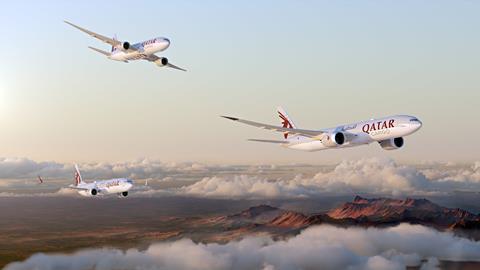Boeing’s launch on 31 January of the 777-8 Freighter means a further delay for the passenger variant of the -8.
Although the US airframer insists it will still build the smallest member of the 777X family, it offers no clarity on when the long-range widebody twin might enter service.

“We remain committed to the 777-8 passenger airplane, which will follow the 777-8 Freighter,” says Boeing. Deliveries of the 777-8F are due to commence in 2027.
That suggests the 777-8 passenger aircraft will not arrive until around 2029 – closing in on a decade behind the original schedule at the 777X programme’s launch in November 2013.
Even Emirates, which is the largest customer for the 777X, has no clarity on when its -8s might arrive.
“We don’t yet have a firm timeline for our first 777-8 delivery, and continue to engage in dialogue with Boeing in this regard,” says the carrier.
Emirates president Sir Tim Clark has previously hit out at Boeing’s lack of communication over the 777-8, saying last October that he was unsure if the variant would even be built.
Boeing adds: “As for timing for the 777-8 passenger model, our customers have told us they need additional freighter capacity first while long-haul passenger traffic continues to recover from the pandemic. We designed a freighter into the 777X family from the start, and this flexibility validates that approach.”
To date, the only disclosed customers for the 777-8 are the big three Gulf carriers, which committed to the 777X amid a collective $95 billion, 250-unit splurge on examples at the 2013 Dubai air show.
At the time, Emirates said it would take 115 777-9s and 35 -8s, Etihad 17 -9s and eight -8s, and Qatar 50 777Xs.
However, it is unclear how many of those aircraft remain on firm order. Emirates renegotiated its commitment in 2019, reducing its total 777X order to 115 jets, and it has not disclosed the split between variants. Meanwhile, a retrenching Etihad has indicated a sharp reduction in its overall commitment.
Although Cirium fleets data lists Qatar as having 10 -8s on order, the fact that its launch deal for the freighter included 20 conversions suggests that its commitment to the smaller passenger variant may not endure.
Emirates adds that “we have not been in discussion with Boeing on the 777-8F”, noting that its November 2021 order for two current-generation 777Fs, plus the conversion of four 777-3000ERs to a cargo configuration, will “satisfy our cargo capacity requirements for the short-medium term”.
The 777-8 is designed to carry 384 passengers in a two-class layout on flights of up to 8,730nm (16,200km), against respective figures of 426 and 7,285nm for the -9.
Although all three variants share the same 71.8m (235ft) wing, at 69.8m the fuselage of the -8 is nearly 7m shorter than that of its passenger sibling, and cedes around 1m to the freighter, according to Boeing’s specifications.


























